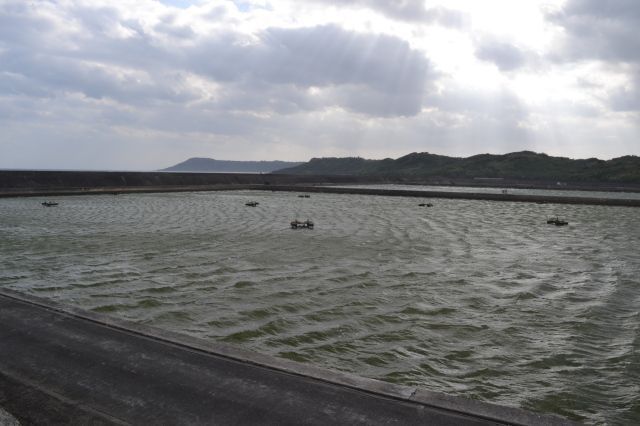1.4 million farm-raised kuruma shrimp killed as disease explodes through farm, losses estimated at 100 million yen

The fishery in Miyakojima where a disease has wiped out all of the kuruma shrimp being raised there – December 1, Miyakojima (Photograph by Shinji Sano)
December 2, 2021 Ryukyu Shimpo
By Shinji Sano
Miyakojima – The Miyakojima Fishery Cooperative disclosed December 1 that around 1.4 million kuruma shrimp being raised in an aquaculture farm in the Miyakojima fishing port were almost entirely wiped out by penaeid acute viremia (PAV), also known as white spot disease. According to the co-op, this is the first time in 28 years of raising shrimp where the amount of shrimp shipped will be zero, and that losses look to reach upwards of 100 million yen. It is unclear how the disease made its way through the population of shrimp, and as a result it is also unclear how the farm will be able to restart breeding. Other fisher operators in the town have not reported any similar infections.
The fishery co-op notified Okinawa prefecture on December 2, and a staff member from the Okinawa Prefectural Fisheries Research and Extension Center was dispatched to the scene. A survey will be conducted at the fishery, and then the fishery co-op and Miyakojima city will confer to discuss next steps.
According to Okinawa Prefecture and the Miyakojima Fishery Cooperative, white spot disease only affects crustaceans, and cannot be transmitted to people. Shrimp have been known to exhibit cannibalism, and the disease can spread by shrimp eating other infected shrimp.
The fishery cooperative has been raising kuruma shrimp since 1993. Baby shrimp are purchased from Kume Island, and raised in three fish ponds (each about 14,000 square meters). Each month, samples are sent to the Okinawa Prefectural Fisheries Research and Extension Center to test for disease.
White spot disease was first discovered in the fish pond by the co-op in 2016. Since then, they remove any of the shrimp that have been infected each year, but since this process overlapped with their shipping season (at the end of November), they are able to remove the infected shrimp and ship the rest. However the infection reduces the amount of shrimp they are able to ship, and since 2016 the fishery operation has been in the red.
This year they held off on shipping when the disease was confirmed in October, and it spread explosively from there. Since the first discovery of disease in 2016, Okinawa Prefecture has also been conducting tests, but they are still not sure how the disease has been spreading.
Each year, the fishery co-op drains the ponds of water, stirs up the sand on the bottom and lets it dry under the sun, as well as thoroughly cleans with chlorine. Co-op president Koji Kuriyama sighed, saying “When breeding density is high it can cause stress which can promote disease transmission, so this year we did not use one of the ponds, an reduced the number of shrimp.”
There are concerns that the disease could spread outside of the fishery, so crustaceans in the area around the fishery were captured and tested, but the results came back negative. “We’ve tried everything. The only thing left is to swap out all of the ground sand, but this would be an enormous expense, and we cannot be sure that this would eliminate the disease.”
(English translation by T&CT and Sam Grieb)
Previous Article:Vivid “Ryukyu Illustration” originating from Koza put on display for Japan
Next Article:Gone back in time? Pupils experience traditional Ryukyu dress at Nakijin Castle during class trip
[Similar Articles]
- Mozuku harvest begins in Miyakojima, yielding “thick, high quality seaweed, a prime result”
- A super-sized haul of high-class spangled emperor fish known as taman brought into Toya Fishing Port in Yomitan, “It will be tasty any way you cook it”
- Large eel appears on road
- Shipping of Japanese tiger prawns starts in Okinawa
- Two new coronavirus cases confirmed on Iriomote Island, including one town employee, and insufficient healthcare on the island has its residents scared
 Webcam(Kokusai Street)
Webcam(Kokusai Street)


